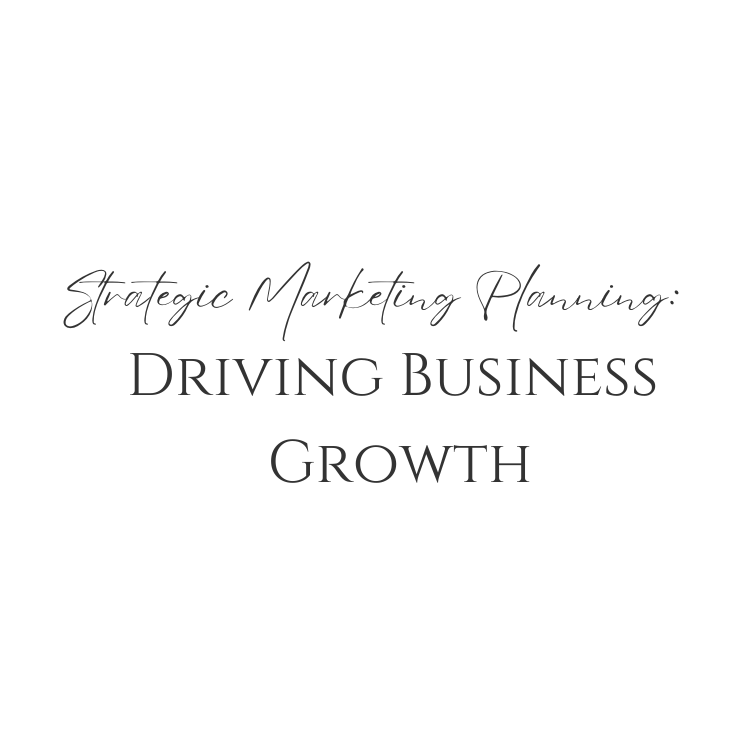Are you looking to drive growth in your business through strategic marketing planning? It’s time to take a step back and analyze your current marketing strategies. Without a clear plan in place, it can be challenging to achieve the results you desire.

Strategic marketing planning involves:
- Understanding your business goals and objectives
- Defining your target audience
- Analyzing competitor activity
- Identifying and prioritizing marketing channels
- Creating a content marketing strategy
- Developing a paid advertising strategy
- Setting measurable goals and key performance indicators (KPIs)
- Monitoring and adjusting your plan as needed.
By following these steps in an organized manner, you will gain valuable insights into what works for your business and how to effectively allocate resources towards achieving growth targets. So let’s dive deeper into each of these critical components of strategic marketing planning.
Key Takeaways
- Strategic marketing planning is necessary for achieving desired business growth results.
- Defining target audience involves understanding psychographics and demographics, deciding whether to market to a niche or mass market, and tailoring marketing efforts to better reach and engage with ideal customer base.
- Identifying and prioritizing marketing channels is crucial, with social media and influencer marketing being two key channels to consider.
- Setting measurable goals and key performance indicators (KPIs) is essential to track progress towards those goals and adjust the plan as needed.
Understand Your Business Goals and Objectives
You need to understand your business goals and objectives if you want to effectively drive growth, so let’s get started!

Aligning strategy with your business goals and objectives is the first step in developing a strategic marketing plan. By doing this, you can ensure that all of your marketing efforts are geared towards achieving these goals and objectives.
Setting metrics is another critical component of understanding your business goals and objectives. Metrics will help you track progress towards meeting those goals and allow for adjustments along the way. It’s important to set both short-term and long-term metrics, so you can celebrate small wins while keeping an eye on the bigger picture.
Creating a roadmap based on your aligned strategy and set metrics will guide the implementation of your marketing plan. This roadmap should include specific tactics, timelines, budgets, resources needed, as well as contingency plans for potential obstacles. Tracking progress against this roadmap will provide insight into what’s working well and what needs to be adjusted moving forward.
Understanding your business goals and objectives is essential in driving growth through strategic marketing planning. Once you have aligned strategy with those goals, set measurable metrics for success, created a roadmap for execution, and begun tracking progress; it’s time to define your target audience without losing sight of the end goal: driving growth!
Define Your Target Audience
Imagine understanding exactly who your ideal customer is, connecting with them on a personal level and seeing your sales skyrocket as a result. Defining your target audience is essential to creating an effective marketing strategy.

The first step is to understand the difference between psychographics and demographics. Psychographics involve understanding the personality traits, values, attitudes, interests, and lifestyle of your target audience. This information provides insight into their motivations for purchasing products or services.
Demographics focus on statistical data such as age, gender, income level, education level, occupation and other similar traits that describe your target audience. Once you have a clear understanding of psychographics vs demographics, you can decide whether to market to a niche or mass market.
A niche market involves targeting a specific group of people with unique needs or characteristics while mass markets appeal to larger groups with more general needs. Understanding the differences between these two approaches will help you tailor your marketing efforts to better reach and engage with your ideal customer base.
With this information in hand, you can now move onto analyzing your competition and identifying gaps in their strategies. Understanding your target audience is crucial in developing an effective marketing plan that drives business growth.
By delving beyond just demographic data into the psychology behind consumer behavior through psychographic research, businesses can develop campaigns tailored specifically for their ideal customer base. Knowing whether a niche or mass-market approach suits the company’s brand identity helps them effectively communicate their message across all channels while remaining authentic at all times; it also aids in setting realistic goals for growth based on where they are positioned within their industry before moving onto analyzing competitors’ strategies for further improvement opportunities without losing sight of what makes them stand out from others competing against them in today’s marketplace.
Analyze Your Competition in Strategic Marketing
Looking at your competition can provide valuable insights into what is working and not working in your industry. Conducting a thorough analysis of the competitive landscape is an important step in developing your strategic marketing plan. This analysis will help you identify key competitors, their strengths and weaknesses, and areas where you can differentiate yourself.

One effective tool for analyzing your competition is a SWOT analysis. A SWOT analysis involves identifying the strengths, weaknesses, opportunities, and threats facing your business within the context of your industry. By conducting a SWOT analysis for each of your key competitors, you can gain a deep understanding of how they are positioning themselves in the market and develop strategies to compete effectively.
To help organize your findings from this competitive analysis, consider creating a table that outlines key information about each competitor. This table could include columns such as company name, product offerings, target audience, pricing strategy, marketing channels used, and key strengths/weaknesses. By visually representing this information in one place, you can quickly identify trends or patterns that may inform your own marketing approach.
Now that you have analyzed your competition using tools like SWOT analyses and competitive landscape research it’s time to move onto identifying and prioritizing marketing channels that work best for reaching out to customers.
Identify and Prioritize Marketing Channels
Discovering the most effective marketing channels for your brand is crucial to driving customer engagement and boosting sales. With so many options available, it’s important to identify and prioritize those that will provide the greatest return on investment.
Two key channels to consider are social media and influencer marketing. Social media offers a powerful platform for engaging with customers and building brand awareness. By creating compelling content and leveraging targeted advertising, you can drive traffic to your website, generate leads, and ultimately increase sales. However, not all social media platforms are created equal – it’s important to choose those that align with your target audience and business objectives.
Influencer marketing is another effective way to reach potential customers. By partnering with individuals who have a large following on social media or in your industry, you can tap into their audience base and benefit from their credibility and influence. When identifying potential influencers, look for those whose values align with yours and who have a genuine connection with their followers.
To effectively drive growth through strategic marketing planning, it’s essential to identify the most effective marketing channels for your brand. Social media and influencer marketing are just two examples of the many options available – by prioritizing these channels based on your specific business objectives, you can maximize results while minimizing costs.
The next step is to create a content marketing strategy that leverages these channels for optimal impact.
Create a Content Marketing Strategy
Creating a content marketing strategy is essential for any brand to effectively engage with customers and increase sales. Content creation involves identifying relevant topics that your audience will find interesting, informative, and engaging. This can be achieved through extensive research on the target market’s preferences and pain points.
Once you’ve identified these topics, it’s crucial to develop a content calendar that outlines when each piece of content will be published. Distribution tactics are just as important as the quality of the content itself. You need to ensure that your content reaches your target audience in the most effective way possible.
This can be done by leveraging social media platforms, email newsletters, guest blogging opportunities, among other channels. The key is to understand where your target audience hangs out online and what channels they prefer using. Incorporating a strong content marketing strategy into your overall marketing plan can help drive business growth by attracting new leads and nurturing existing ones.
However, creating high-quality content is only one part of the equation; promoting it effectively is equally important. Developing a paid advertising strategy can help supplement organic reach and increase visibility even further – this will be discussed further in the subsequent section about developing a paid advertising strategy.
Develop a Paid Advertising Strategy
To amplify the reach of your content and target specific audiences with precision, it’s essential to develop a paid advertising strategy that utilizes various ad formats across relevant channels.
Ad targeting is a crucial component of any paid advertising strategy, as it allows you to identify and reach your ideal customers based on factors such as demographics, interests, behaviors, and location.
By creating targeted ads that speak directly to the needs and desires of your audience, you can increase the likelihood of conversions while minimizing wasted spend.
Another critical factor in developing a successful paid advertising strategy is budget allocation. It’s important to determine how much you’re willing to spend on each campaign and allocate those funds strategically across different channels based on their effectiveness in reaching your target audience.
Additionally, setting aside a portion of your budget for testing new ad formats or targeting options can help you identify what works best for your business over time.
By developing a comprehensive paid advertising strategy that incorporates ad targeting and budget allocation best practices, you can drive meaningful results for your business.
However, it’s important not only to set up campaigns but also set measurable goals and key performance indicators (KPIs) to track progress towards those goals.
This will allow you to measure success against concrete metrics such as click-through rate (CTR), conversion rate (CVR), return on ad spend (ROAS), or cost per acquisition (CPA).
Set Measurable Goals and Key Performance Indicators (KPIs)
Achieving your desired outcomes is like navigating a ship through rough waters, which is why setting measurable goals and KPIs can act as your compass to guide you towards success.
Before diving into the implementation of any marketing plan, it’s essential to define what success looks like for your business. This involves setting specific, measurable goals that align with your overall business objectives.
To ensure that you’re on track towards achieving these goals, it’s crucial to set Key Performance Indicators (KPIs) that allow you to measure progress accurately. These metrics should be tied directly to your goals and provide insight into how well your marketing efforts are performing.
By tracking progress towards specific KPIs regularly, you can quickly identify areas where improvements are necessary and adjust your strategy accordingly.
Measuring success and tracking progress go hand in hand when it comes to strategic marketing planning. By establishing clear goals and KPIs at the outset of your campaign, you’ll have a solid foundation for evaluating its effectiveness throughout its lifespan.
It’s important not only to monitor but also adjust the plan as needed based on these measurements. In doing so, you’ll ensure that each step taken contributes meaningfully toward driving business growth and achieving long-term success.
Monitor and Adjust Your Plan as Needed
You need to be vigilant in monitoring and adjusting your marketing plan as needed if you want to stay ahead of the competition and make a lasting impact on your target audience. One key factor in successful strategic planning is flexibility.
Even the best-laid plans can go awry, so it’s important to be open to change as new information becomes available. Real-time monitoring and adjusting is crucial for any business looking to succeed in today’s fast-paced marketplace.
By tracking your progress regularly, you’ll be able to identify potential issues before they become major problems and adjust your strategy accordingly. This will help ensure that you’re always on track towards meeting your goals, no matter what challenges may arise along the way.
Having a solid strategic marketing plan is only half the battle. The other half lies in being flexible enough to make adjustments as necessary based on real-time data and feedback from your target audience.
By taking this approach, you’ll not only stay ahead of the competition but also create a stronger connection with your customers that will ultimately drive business growth over time. So keep an eye on those metrics, stay nimble, and don’t be afraid to pivot when needed!
Frequently Asked Questions
How much should be allocated for the marketing budget?
As the saying goes, “you have to spend money to make money.”When it comes to marketing budget allocation, prioritize ROI analysis. Look for areas where you can innovate and experiment to maximize returns while minimizing risk.
What are some common mistakes businesses make when creating a marketing plan?
When creating a marketing plan, businesses often make the mistake of neglecting competitor research and failing to identify their target audience. Avoid these errors by conducting thorough research and analyzing your market to reach your desired demographic successfully.
How do you measure the success of a marketing campaign?
You can measure the success of your marketing campaign by analyzing ROI and customer engagement metrics. These give you a clear indication of how well your strategy is working, allowing for further innovation and growth.
Should the marketing plan be adjusted frequently or only as needed?
When determining the marketing plan adjustment frequency, consider external factors such as market trends and competitor actions. Adjustments should be made strategically to ensure goals are met and innovation is prioritized.
What are some effective ways to track and analyze customer behavior and preferences?
Imagine your customers as a diverse group of animals. By using customer segmentation and data analytics, you can track the behavior and preferences of each type of animal to better understand their needs and tailor your marketing strategies accordingly.
Conclusion
Congratulations, you’ve successfully completed the steps towards driving business growth through strategic marketing planning. By following the guidelines outlined above, you’ve gained a better understanding of your business goals and objectives. You’ve also defined your target audience, analyzed your competition, identified and prioritized marketing channels, created a content marketing strategy, developed a paid advertising strategy, set measurable goals and KPIs, and monitored and adjusted your plan as needed.
Parallelism is key to effective communication in strategic marketing planning. It helps convey information clearly and concisely while making it more enjoyable and relatable. With this technique in mind, you can create a powerful message that resonates with your target audience.
Remember that strategic marketing planning is an ongoing process that requires continuous monitoring and adjustments to ensure success. Stay focused on achieving your goals by remaining analytical, professional, and strategic at all times.
Good luck!




